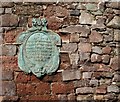King William III of England
_(lighter).jpg?width=250)
_(lighter).jpg?width=250)
King William III of England
(1650-1702)
Prince of Orange (1650-1702), King of Scots (1689-1702), and King of England (1689-1702)
Family tree
Commemorated on 8 plaques
Site of West Gate. Successfully defended against the rebel attacks in 1549, William Prince of Orange with his army entered the city in 1688 through this gate which was removed in 1815.
West Street, Exeter, United Kingdom where they with his army entered the city through this gate (1687)
To commemorate the landing of King William III at this pier on 14th. June 1690
Harbour, Carrickfergus, United Kingdom where they landed (1689)
6 feet south east of this slab the Regium Donum was signed by King William III of glorious memory to the Presbyterian Body which they were deprived of by ?? 1869
Hillsborough fort, Co Down, Hillsborough, United Kingdom where they visited
WR III Rotten Row The King's Old Road completed 1690. This ride originally formed part of King William III's carriage drive from Whitehall to Kensington Palace. Its construction was supervised by the surveyor of their Majesties roads Captain Michael Studholme and it was the first lamp-lit road in the Kingdom. Designated as a public bridleway in the 1730's, Rotten Row is one of the most famous urban riding grounds in the world. ER II 1990
Hyde Park, London, United Kingdom where they visited
The Royal Hotel. Late 18th Century Grade II listed building. Until at least 1817, it was known as The White Hart Inn. According to tradition, Prince William of Orange once stayed here, after which it became known as The Royal Hotel.
The Royal pub, High Street, Runcorn, United Kingdom where they stayed
This mansion, built about 1690, was the residence of Sir Isaac Rebow, B. 1655; D, Sept. 19, 1726. M.P. for Colchester 1692-1722 High Steward of the Borough; Recorder, 1723-1726; Mayor, 1716-7. Knighted, March 27, 1693, by King William III, who thrice visited this house viz., on March 27, 1693; Oct. 29, 1693; Oct. 19, 1700.
No. 62 Head Street, Colchester, United Kingdom where they visited (1693), visited (1693), and visited (1700)
William III stayed here with Thomas Medlycott, recorder of Abingdon, on December 11th 1688 when on his way from Torbay to London.
39 E St Helen St, Abingdon, United Kingdom where they was
WILLIAM AND MARY On the 7th December 1688 William of Orange arrived at The Bear on his march from Torbay to London meeting here on the morning of the 8th James II's Commissioners Lords Halifax Godolphin and Nottingham HUNGERFORD CELEBRATION 1688-1988
41 Charnham St, Hungerford, United Kingdom where they stayed (1688)








